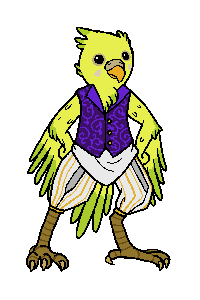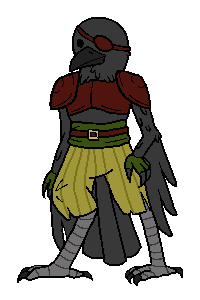| PTAK |
  |
| OF A FEATHER |
| Ptak stand on digitigrade legs and have a pronounced forward lean, though not to the extent of flighted birds. Puffed feathers and down bulk out their chests and lend them a vee-shaped silhouette from the shoulders down. Kruk brows are low and beetling, and papuga plumage on the tops of their heads give the impression of a high forehead or pompadour. Neither seems particularly slender: papuga can appear stocky and kruk broad and tall. The longest feathers are on tails and forearms and are the vestiges of their now-lost ability to fly. |
| JUST A LARK |
| Easygoing ptak always seem to have an eye on the horizon, rather than the ground. Introspection is not a common trait among their kind. That’s time better spent looking around, poking and prodding shiny objects, or getting to where one is going. Rules and restrictions get in the way of all that, and who has time for such? Ptak have a particular love of jokes and teasing though such is not necessarily benign: it can be cruel mockery or relentless bullying when unwanted. Flouting authority covertly or overtly seems to bring similar joy. None of this is to say ptak are unserious. Indeed, when they are ruthless it can be all the more shocking for the humor which accompanies it. |
| PECKING ORDERS |
| No matter their company, ptak are quick to
identify who’s in charge and who isn’t. They can be a thorn in the
side of a leader, constantly testing with varying degrees of
seriousness. It is important to understand, however, that this is
not rebelliousness in a way that other mortals are familiar with
as ptak can be loyal to a fault. The intent is not to destroy a
group or its leader, but to always understand where the ptak fits
within the group. When one happens to be in charge themselves they
seldom miss a chance to let everyone else know it. Large groups of
ptak usually follow the toughest, wiliest, or most charismatic
among them, and smaller groups within do the same in a very
informal feudal structure. Historically, ptak have not been known
as nation-builders, but in mixed groups of mortals, they boast
examples of renowned leadership. Kinship has only muted importance
to their kind. Young are sometimes communally raised, and
parentage is usually disregarded once ptak have reached adulthood. |
| NEVER WANTING A CAGE |
| The wanderlust that infects ptak makes them
natural adventurers. Even settled ptak find it easy to drop
everything and set off for parts unknown. A ptak will try nearly
anything once, twice if it was funny the first time. In the right
group, they’re an endless boon: inquisitive, eager, and full of
good humor. In the wrong group, they’re an eternal nuisance:
boastful, irritating, and insubordinate. |
| PTAK NAMES |
| Ptak names in their own language are very
distinct, having precise pitch and tone and are nigh-unique.
However, other races cannot accurately reproduce these sounds,
leading ptak to embrace easy nicknames, sometimes based on a
physical trait. Example Nicknames: Cloudy, Big Hammer, Shrieker, Buddy, Lefty, Two-toes, Fluff, Strawberry |
| PTAK TRAITS |
| Ability score increase. Your
Dexterity score increases by 2. Age. Ptak reach adulthood at age 14 and can live up to a century. Alignment. At the risk of picking the obvious description, the ptak are flighty. What sounds fair one day might be thought of less highly the next. They tend towards a chaotic ethical outlook. Memory of Flight. While Ptak cannot fly, they are able to land safely from falls if they are conscious and their arms are not restricted. This functions as the Feather Fall spell. Once they have used this safely, they cannot do so again until completing a short or long rest. Mimicry. You can mimic sounds you have heard, including voices. A creature that hears the sounds can tell they are imitations with a successful Wisdom (Insight) check opposed by your Charisma (Deception) check. Sharp Eyes. You have proficiency in the Perception skill. Languages. You can speak Common and Ptak, and read and write Common. The Ptak language is composed of clicks, whistles, screeches, and snatches of warbling that is nigh impossible for non-Ptak to reproduce, and has no written language. Subraces. There are two subraces of Ptak: Kruk and Papuga. Kruk The larger kruk have no problem throwing their weight around, even if they are lighter than most other races. They have a bold sense of entitlement that can rub some the wrong way, but they are fierce allies to those they call friends. Their beaks are sharp and straight, and their plumage can be black or less frequently white or grey. Ability score increase. Your Strength score increases by 1. Size. Kruk range between 5 and 6 feet in height and can weigh up to 180 pounds. Your size is Medium. Larcenous. You are proficient in a skill of your choice: Sleight of Hand or Stealth. Bruiser. You have advantage on Strength ability checks. Papuga Smaller and more brightly colored, papuga are flamboyant and love to be the center of attention. They talk big despite their small frames and apparently mean every word of it. Their beaks are hooked, and their plumage ranges from green to blue to yellow. Ability score increase. Your Charisma score increases by 1. Size. Papuga range between 4 and a half and 5 and a half feet in height and can weigh up to 160 pounds. Your size is Medium. Bombastic. You are proficient in a skill of your choice: Acrobatics or Deception. Loves Riddles. You have advantage on Intelligence ability checks to detect illusions. |
| PTAK ADDENDA |
| Seabirds Since the introduction of sailing to the ptak by the iaret, maritime exploits have been a particular fascination. Ptak love the open skies, endless expanses of water, and the wind in their feathers. The adventure and drama of ships on the sea, pitted against the elements or each other without the distraction of solid ground appeals like little else. The size of a sailing vessel’s crew and the top-down hierarchy of naval discipline also fits neatly into ptak preferences for the size and governance of a “flock.” Plumage Of all races, ptak have perhaps the least need of clothing, but also the greatest love of adornment. Feathers reduce demand for modest attire, at least in the eyes of other mortals, and ptak are not shy of going without. However, if the feathers one is born with are lovely, they could be even lovelier with more decoration! Shiny things are prized by the ptak and “shiny” has a wide definition. Gold thread, polished leather, satin, even the way crushed velvet can catch the light fascinates their kind. Due to the shape of their bodies, ptak require special tailoring for their garments, and rarely does a clothier who can make alterations for them go bankrupt. Good taste in attire, however, remains subjective and here the ptak may have some deficiency. Old Friends Legends of the ptak inhabiting the high mountains, much like cautionary tales about ozrut, have been present in iaret literature since the start of recorded history. In many ways, they are the natural foil of their ferocious or dour neighbors: tricksters rather than despoilers, friendly rather than insular. The ozrut acknowledge ptak in their oldest tales, even allowing that they might be a by-blow of Father Cloud. This is high praise from ozrut. In the first recorded encounter between the iaret, the ptak spoke both ozrut and iaret already, and identified themselves using ozrut words. Thus the terms “ptak,” “papuga,” and “kruk” entered usage. The complementary nature of ozrut and ptak and their fond regard for each other have prompted comparison with the iaret and apkallu relationship among natural philosophers. It is generally accepted that ozrut demeanors limited the possibility that such might be as fruitful a partnership, however. In Their Voices Mimicry is far from just a parlor trick for the ptak. Because their own language is beyond the ability of other mortals to produce without aid, it is how they interact with the wider world. In some ways, this unique talent is one of the most pure expressions of their being. They borrow language, first from the ozrut, they eagerly take to foreign fashions and customs, they love sailing without having invented ships, but at the heart of this gleeful adoption is ptak mimicry. Men and Maidens To most other races, the visual cues to separate ptak males from females are absent. Aside from slight differences in plumage and size, outsiders can be confounded on how to address a ptak they just met. Raiment is sometimes a clue, but the avidity with which ptak dress in whatever catches their fancy means this is no sure bet. Their skill with imitating voices is no help either. Ptak certainly have no trouble in identifying themselves, but are more than aware of the confusion they can cause and some can’t resist exploiting it for their own amusement. The Gifts of the Gods Like the ozrut, the ptak revered the gods in an altered form prior to contact with the iaret. Chief among their beliefs is the Greatest Flock, a goddess of many bodies now recognized as Ranute. Typically of the ptak, their reverence is seasoned with a great deal of humor. She may have fed them in their infancy with her thousand mouths, but she was too watchful a mother and her gifts weighed down the ptak and left them unable to fly. Many ptak myths feature the protagonist somehow tricking Ranute in order to slip out from under her wing. The Egg’s Way Three months after conception, ptak lay clutches of one to three hard-shelled eggs each about the size of an iaret skull. Egg-laying takes up to six days. The eggs must be brooded for three months before the young are able to break the shell and begin hatching. After hatching, ptak young are helpless and dependent on adults for another three months before they can digest solid food. Eaters of the Dead Sova are unique among ptak in that they are obligate carnivores. Among the omnivorous papuga and kruk, this is regarded as especially aberrant, and believed to be the result of being cursed by the Greatest Flock for spurning her gifts. Sova prefer meat raw and can swallow prodigious amounts in a single gulp, but the arts of cooking and preservation do exist amongst their kind. |